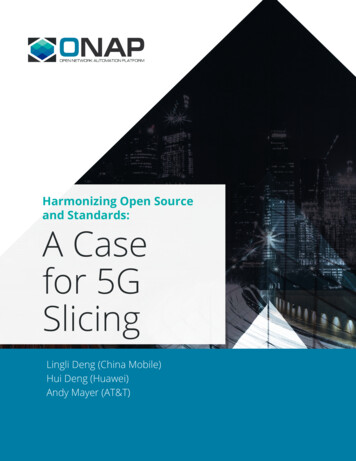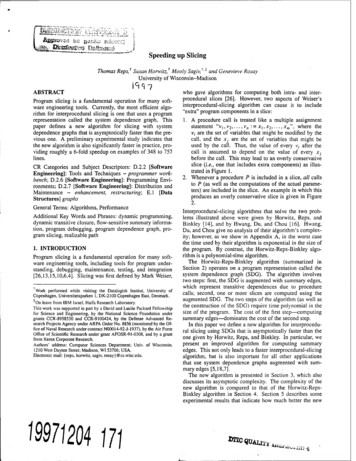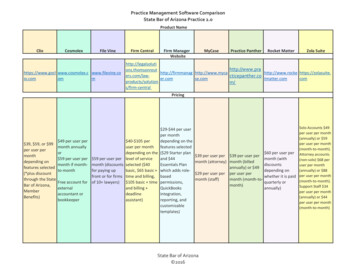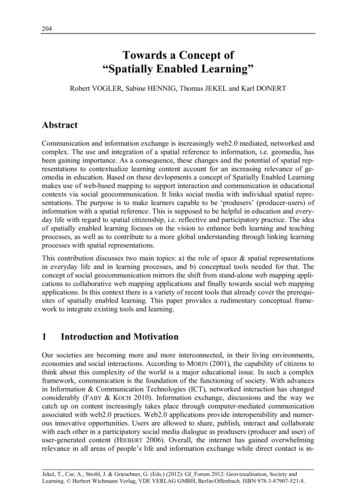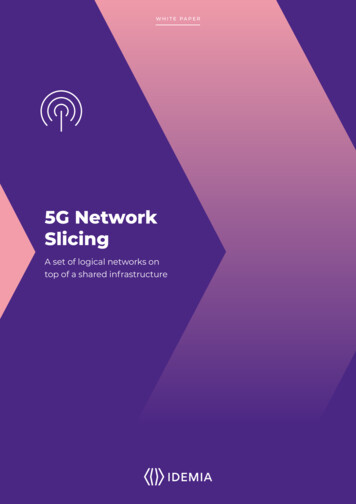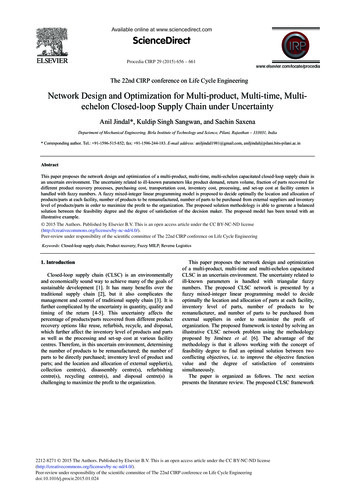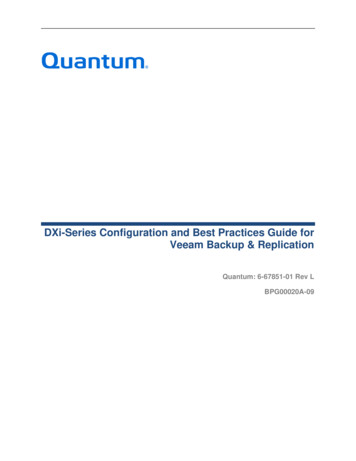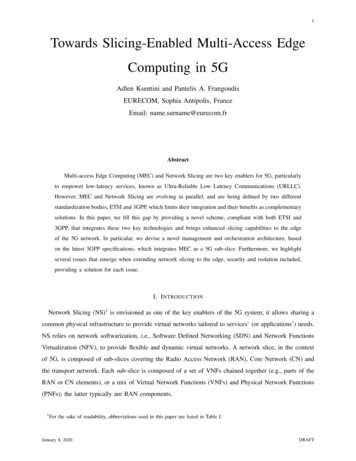
Transcription
1Towards Slicing-Enabled Multi-Access EdgeComputing in 5GAdlen Ksentini and Pantelis A. FrangoudisEURECOM, Sophia Antipolis, FranceEmail: name.surname@eurecom.frAbstractMulti-access Edge Computing (MEC) and Network Slicing are two key enablers for 5G, particularlyto empower low-latency services, known as Ultra-Reliable Low Latency Communications (URLLC).However, MEC and Network Slicing are evolving in parallel, and are being defined by two differentstandardization bodies, ETSI and 3GPP, which limits their integration and their benefits as complementarysolutions. In this paper, we fill this gap by providing a novel scheme, compliant with both ETSI and3GPP, that integrates these two key technologies and brings enhanced slicing capabilities to the edgeof the 5G network. In particular, we devise a novel management and orchestration architecture, basedon the latest 3GPP specifications, which integrates MEC as a 5G sub-slice. Furthermore, we highlightseveral issues that emerge when extending network slicing to the edge, security and isolation included,providing a solution for each issue.I. I NTRODUCTIONNetwork Slicing (NS)1 is envisioned as one of the key enablers of the 5G system; it allows sharing acommon physical infrastructure to provide virtual networks tailored to services’ (or applications’) needs.NS relies on network softwarization, i.e., Software Defined Networking (SDN) and Network FunctionsVirtualization (NFV), to provide flexible and dynamic virtual networks. A network slice, in the contextof 5G, is composed of sub-slices covering the Radio Access Network (RAN), Core Network (CN) andthe transport network. Each sub-slice is composed of a set of VNFs chained together (e.g., parts of theRAN or CN elements), or a mix of Virtual Network Functions (VNFs) and Physical Network Functions(PNFs); the latter typically are RAN components.1For the sake of readability, abbreviations used in this paper are listed in Table I.January 8, 2020DRAFT
2Edge computing is a complementary solution to sustain low latency for time-critical services, knownin 5G as URLLC services. In this context, ETSI is leading standardization activities around Multi-accessEdge Computing (MEC). Several 5G use-cases are expected to rely on MEC to deliver added valueservices to the end users. In addition to providing an execution environment for running applications atthe edge, MEC provides services that supply information on end user and base station (eNB) context, suchas the radio channel quality of users and their location in the network, allowing to build context-awareapplications.Meanwhile, 3GPP has put efforts [1], [2] into integrating NS in the future specification of both theRAN and CN. Importantly, 3GPP has created three Service and System Aspects (SA) groups, SA1, SA2and SA5, which aim to, respectively, update the RAN, the CN, and describe a management frameworkfor Network Slicing in 5G. First results of these groups are: (i) the usage of a slice identifier (SNSSAI: Single-Network Slice Selection Assistance Information), when the User Equipment (UE) firstconnects to the RAN; (ii) the introduction of a new CN architecture, which is virtualization-ready, andintegrates a Network Slice Selection Function (NSSF) that aims to help the RAN select the CN functionscorresponding to a UE’s S-NSSAI; (iii) a new framework that manages the life cycle of 5G network slices.However, the support of NS in MEC is in its infancy. A recent group [3] has been constituted to evaluateto what extent MEC can support NS. Its first document describes only some use-cases and requirementsto support NS at the MEC level and many points are kept open. First, a new MEC architecture shouldbe devised and aligned with (i) the current 3GPP specifications to fit with the 5G architecture at boththe RAN and CN, and (ii) the integration of MEC in NFV, while considering the new Network Slicingmanagement framework as introduced by 3GPP. Second, the MEC service model should be revised inorder to guarantee security and isolation for network slices. Finally, the registration and discovery ofMEC services, provided by third-party MEC applications, need to be adapted to the context of slicedMEC.In this article, we address the aforementioned gaps by proposing a novel orchestration/managementarchitecture that allows to deploy a MEC platform as well as MEC applications in a 5G environment thatsupports NS, while being aligned with the new MEC-in-NFV ETSI recommendations [4]. Furthermore,we discuss some issues regarding NS security and isolation, as well as the registration of MEC servicesby third-party application providers when slicing MEC; for each concern, we provide solutions. Finally,we report on our experiences implementing a fully-fledged, standards-compliant MEC system, providingsome technical solutions and extensions for the support of NS in MEC-in-NFV, as well as presentingsome early performance results from our testbed. To the best of our knowledge, this article is the first tointroduce solutions for sliced MEC, and the integration of the latter in the 5G Network Slicing model.DRAFTJanuary 8, 2020
3TABLE IG LOSSARYJanuary 8, 2020AbbreviationName3GPP3rd Generation Partnership ProjectAFApplication FunctionAMFAccess and Mobility management FunctionAPIApplication Programming InterfaceAppDApplication DescriptorBSSBusiness Support SystemCNCore NetworkCSMFCommunication Service Management FunctionDNData NetworkDNSDomain Name SystemeNBevolved Node BETSIEuropean Telecommunications Standards InstituteISGIndustry Specification GroupMANOManagement and OrchestrationMEAOMEC Application OrchestratorMECMulti-access Edge ComputingMEOMEC OrchestratorMEPMEC PlatformMEPMMEP ManagerNEFNetwork capability Exposure FunctionNFVNetwork Functions VirtualizationNFVINFV InfrastructureNFVONFV OrchestratorNSNetwork SlicingNSDNetwork Service Descriptor (NSD)NSINetwork Slice InstanceNSMFNetwork Slice Management FunctionNSSINetwork Slice Subnet InstanceNSSMFNetwork Slice Subnet Management FunctionNSTNetwork Slice TemplateOAIOpenAirInterfaceOSSOperations Support SystemPCFPolicy Control FunctionPKIPublic Key InfrastructurePNFPhysical Network FunctionRANRadio Access NetworkRAMRandom Access MemoryRNISRadio Network Information ServiceSASystem AspectsSDNSoftware Defined NetworkingS-NSSAISingle-Network Slice Selection Assistance InformationUDMUser Data ManagementUEUser EquipmentURLLCUltra Reliable and Low Latency CommunicationUPFUser Plane FunctionVIMVirtual Infrastructure ManagerVNFVirtual Network FunctionVNFDVNF DescriptorDRAFT
4Fig. 1. High-level representation of the MEC architecture (based on [5]).II. R ELATED WORKA. ETSI MECThe ETSI MEC ISG has been working on the development of standardization activities around MECsince 2013. Its first released document covers the reference architecture [5]. A high-level representationof this architecture is shown in Fig. 1. It introduces three main entities: The MEC host, which provides the virtualization environment to run MEC applications, whileinteracting with mobile network entities via the MEC platform (MEP) to provide MEC servicesand data offload to MEC applications. Two MEC hosts can communicate via the Mp3 interfaceaiming at managing user mobility via the migration of MEC applications among MEC hosts. The MEC platform (MEP), which acts as an interface between the mobile network and the MECapplications. It has an interface (Mp1) for MEC applications to expose and consume MEC services,and another (Mp2) to interact with the mobile network. The latter is used to obtain statistics fromthe RAN on UEs and eNBs, e.g., in order to provide the Radio Network Information Service (RNIS)and the Location Service, and to appropriately steer user-plane traffic to MEC applications. MEC applications that run on top of a virtualized platform.Another concept introduced by ETSI MEC is the MEC service, which is either a service provided nativelyby the MEP, such as the RNIS and traffic rules control, or a service provided by a MEC application,e.g., video transcoding. MEC services provided by third-party MEC applications should be registeredwith the MEP and made available over the Mp1 reference point. Once registered, a service may beDRAFTJanuary 8, 2020
5Fig. 2. Updated version of the MEC architecture featuring MEC in NFV (based on [4] and [5]).discovered and consumed by other MEC applications. Regarding the management plane, ETSI MECintroduced the Mobile Edge Orchestrator (MEO), which is in charge of the life-cycle of MEC applications(instantiation, orchestration and management), and acts as the interface between the MEC host and theOperations/Business Support System (OSS/BSS).Considering the advantages brought by NFV, and aiming to integrate and run all MEC entities in acommon NFV environment, the ETSI MEC 017 working group drafted a document [4] to update thereference architecture as shown in Fig. 2. These updates have been included as an NFV-oriented variantin the most recent version of the MEC framework and reference architecture specification [5]. In thisvariant, the MEP and MEPM are run as VNFs. The MEO is renamed to MEAO (Mobile Edge ApplicationOrchestrator), maintaining the same functionality, but using the NFVO to instantiate MEC applicationsas well as the MEP and MEPM. Consequently, all the processes of instantiation and management ofresources follow the well-defined NFV interfaces. By doing so, edge resources can be seen as classicalcomputation and storage ones, and can be managed by the same Virtual Infrastructure Manager (VIM)software.B. Network slicing support in 5G networksRelease 15 of the 3GPP standard includes NS specifications for 5G. Remarkably, the CN has beendecomposed into fine-granular Network Functions (NFs), moving from a monolithic core network into amore modular one. Fig. 3 illustrates the service-based 5G reference architecture. The most prominent NFsare Access and Mobility Management Function (AMF), Session Management Function (SMF), User PlaneFunction (UPF), User Data Management (UDM), Network Slice Selection Function (NSSF), NetworkJanuary 8, 2020DRAFT
6Fig. 3. 5G Core Network service-oriented architecture.capability Exposure Function (NEF), Policy Control Function (PCF), and Application Function (AF). Allthe NFs expose APIs to provide one or more services to other NFs, following the producer-consumerconcept.In this article, we focus on user-plane functions (SMF, PCF and UPF), as MEC requires the definitionof traffic policies to redirect traffic to the appropriate MEC applications. More details on the other 5Gfunctions can be found in [2]. The UPF is the function in charge of routing user plane traffic to theappropriate Data Network (DN). It gets its configuration from the SMF, which is one of the key elementsfor user-plane traffic management. Among the various functions of the SMF, such as IP address allocationand management, and session management, is the control of the UPF by configuring traffic rules. TheSMF exposes service operations to allow another function or 5G AF to use policy and traffic rules toreconfigure the UPF, via (i) the PCF, if the 5G AF is a trusted application, or (ii) the NEF, for untrustedAFs.In the 5G architecture, the MEP will be integrated as a 5G AF [6], trusted or not, depending on theuse-case. It may request traffic redirection for a MEC application as per the request of the MEAO viathe MEPM. Therefore, if MEP is a trusted 5G AF, it can use directly the PCF to generate a policy tooffload traffic towards the MEC application. If it is not considered as a trusted 5G AF, it uses the NEFto access the SMF, via its traffic filter policy API, and requests the traffic redirection.The 3GPP, via the SA5 group, has also defined a framework for the orchestration and management ofthe Network Slice life-cycle. The 3GPP approach is based on two basic concepts: Network Slice InstanceDRAFTJanuary 8, 2020
7(NSI) and Network Slice Subnet Instance (NSSI). The NSI, at the fundamental level, is composed of NFs(both AN and CN ones), realized with corresponding physical and logical resources, and its compositionis described by a NS Template (NST) that can be individually enriched with some instance-specificinformation (parameters, policies).The 3GPP approach defines the following management functions related to NSSI, listed below in theorder corresponding to their hierarchy: Communication Service Management Function (CSMF). The CSMF manages Communication Services provided by the Network Operator according to the requirements of the CommunicationService Customer, converts these requirements to NS requirements (e.g., network type/capacity,QoS requirements, etc.), and delegates the management of NSIs to NSMFs. Network Slice Management Function (NSMF). The NSMF manages NSIs, according to the requirements from the CSMF, and further converts/splits them to NSS requirements and delegatesmanagement of NSSIs to NSSMFs. Network Slice Subnet Management Function (NSSMF). NSSMF manages NSSIs based on therequirements received from the NSMF.It should be noted that the NST describing a Network Slice is composed when the vertical (i.e., sliceowner) requests the creation and deployment of a NSI.III. N ETWORK S LICING INCLUDING MECStemming from the facts that (i) 3GPP has released a new architecture model to integrate NS in 5G, anda new framework to manage NS, and (ii) the ETSI MEC group has proposed a solution to integrate MECin NFV, there is a need to update the current MEC architecture to comply with these developments,aiming at supporting NS at the MEC level. We distinguish two models for the support of NetworkSlicing in MEC. The first model assumes that the MEP is already deployed at the edge NFVI and isshared among the slices; we term it the multi-tenancy model. In the second model, the MEP is deployedinside the slice. This is what we call in-slice deployment. For both models, we assume that the MEP isdeployed as a VNF. The MEP and MEC applications are described using a VNF Descriptor (VNFD) andApplication Descriptors (AppDs), respectively. VNFDs and AppDs describe the necessary informationrequired by the NFV Orchestrator (NFVO) and VIM to deploy instances of virtual applications, eitherat centralized clouds or the edge. AppD is specific to MEC applications, containing special fields suchas traffic steering rules and MEC services required by the application. Note that we consider the MEPMas the Element Manager (EM) of the MEP. Fig. 4 shows the global picture highlighting the envisionednetwork slicing orchestration/management architecture as proposed by 3GPP, and featuring MEC slicing.January 8, 2020DRAFT
8Fig. 4. The proposed network slicing orchestration/management architecture, including MEC, in a 5G environment.In terms of interfaces, we mainly highlight those needed to orchestrate and manage core and edge virtualapplications. The RAN controller is the element that provides a northbound control interface to manageeNBs, while using a southbound protocol, such as FlexRAN [7], in order to remotely configure eNBs(e.g., to associate to a new AMF of a slice) or to obtain RAN-level information, such as UE statistics,which can be used by the operator or exposed to interested applications over the RNIS MEC API.We assume that a vertical first accesses a front end (such as a web portal) to request the creationof a network slice, using the NST made available by the CSMF. The NST can be extended accordingto the vertical needs, and by integrating network functions displayed by the CSMF through its networkfunctions store or catalogue (i.e., add more MEC applications). The CSMF forwards the NST to requestthe creation of an end-to-end network slice composed by several sub-slices that span the RAN, CN, MECand transport network. The NSMF organizes the NST into sections corresponding to each sub-slice. TheManagement and Orchestration (MANO) NSSMF component covers the CN functions and VNFs thatneed to be deployed over the cloud. All the network functions that need to be deployed over MECshould be managed by the MEC NSSMF. The NSSMF accepts as input a Network Service Descriptor(NSD) [8] that contains VNFDs as well as AppDs. The NSMF requests the creation of each sub-sliceto the corresponding NSSMF, as illustrated in Fig. 4. The RAN NSSMF is in charge of updating theDRAFTJanuary 8, 2020
9configuration of the RAN, via a RAN controller that interacts with the involved eNBs (PNFs) indicatedin the NST. The NSSMF in charge of CN and VNF instantiation, requests the instantiation of the NSDto the NFVO using the Os-Ma-NFVO interface [9]. The MEC NSSMF interacts with the MEAO byproviding the AppDs of the applications that need to be deployed at the edge NFVI. The MEAO will usethe same NFVO (as specified in [4]) to request the creation of the AppD instance at the selected edgeNFVI. Among the available edge NFVIs, the MEAO can pick the appropriate by executing its internalplacement algorithm, considering different criteria such as latency and service availability [10]. Oncethe application is instantiated, the MEAO is informed of the MEC application’s IP address, which itcommunicates to the MEC platform along with parameters such as specific traffic filters to enforce trafficsteering. The last sub-slice is about the transport part, where we assume that the NSSMF managing itinteracts with Software Defined Networking (SDN) controllers to isolate and forward NS traffic to theInternet.Once each sub-slice is created, the NSMF is in charge of stitching them together to build the end-toend slice. Stitching consists in interconnecting the different sub-slices using a sub-slice border API, asdescribed in [11].A. Multi-tenancy modelIn the case of MEP multi-tenancy, the MEP and UPF are already deployed. The MEP is aware ofthe IP addresses and interface endpoints of the NEF or PCF for traffic redirection, as well as those ofthe RAN controller, from which it can gather the necessary RAN-level data to provide MEC servicessuch as the RNIS. Once the MEC application is deployed by the NFVO, the latter informs the MEAOabout the successful instantiation of the MEC application, along with its IP address. The MEAO then,via Mm3, requests the MEP to enforce traffic redirection rules as indicated in the AppD. Based on thedescription presented in Section II-B, the MEP, via the PCF’s API, requests the redirection of specifictraffic (via a traffic policy) toward the newly created MEC application. Here, the MEP uses the PCF, asit is considered a trusted 5G AF: the MEP has been deployed by the network operator as a common 5GAF for all slices.B. In-slice deployment modelIn this case, the MEP has to be deployed along with the MEC application at the edge NFVI. Unlike themulti-tenancy model, here the MEAO requests the instantiation of both the MEP and MEC applicationat the same time. The NFVO deploys both, and ensures that there is a virtual link between them. As inJanuary 8, 2020DRAFT
10the previous case, the NFVO acknowledges the creation of the MEP and MEC application instances andindicates their IP addresses.We differentiate between two cases: (i) all the CN elements (including the UPF) are deployed insidethe slice; (ii) the UPF is already deployed. In the first situation, the UPF is deployed also at the edge (forthe sake of performance), and the MEP can implement traffic redirection using the internal PCF of thenetwork slice. For the second scenario, the MEP has to discover the NEF of the operator, as the MEP isnot considered as a trusted 5G AF. To solve this, we propose that the DNS service running at the edgeNFVI is used: Once instantiated, the MEP sends a DNS request to discover the NEF’s IP address, andcommunicates with the latter to apply traffic redirection rules.Regarding the needed access to the eNBs in order to provide MEC services (e.g., RNIS, LocationService), we propose to use the concept of zones, as introduced in [12]. A zone indicates an area coveredby a group of eNBs associated with a MEC host. These eNBs are assumed to be managed by a single RANcontroller. For both scenarios, the MEP can use DNS to discover the RAN controller that corresponds tothe zone where it is instantiated, which in turn allows the MEP to retrieve RAN-level information fromall eNBs of the zone.IV. S ECURITY AND I SOLATIONOne of the major requirements in Network Slicing is traffic isolation and security enforcement. EachNS should share the common infrastructure in a secure way. It shall not “see” the traffic of other slices,nor have access to information on other running slices. Two challenges thus arise with respect to MECslicing: (i) The traffic redirection mechanism should ensure that a NS (i.e., the MEC application instancesit includes) cannot specify a traffic redirection policy for traffic it does not “own”; (ii) a Network Sliceshould not be able to use MEC services (e.g., native ones, but also MEC services exposed by other slices)in a way that it gets unauthorized access to information on other running Network Slices, or consumeMEC services not available for it. In the following, we propose solutions to overcome the aforementionedissues.A. Traffic redirectionEach MEC application is described using an AppD. The AppD integrates information specific to a MECapplication, among which the appTrafficRule field. This specifies the characteristics of the trafficrequested by the application. It includes a traffic filter, which allows to specify the traffic to offload, suchas flows identified by combinations of IP source address, IP destination address, source port, destinationport, protocol, and others. Also, the MEC application provider is allowed to add a list of appDNSRuleDRAFTJanuary 8, 2020
11elements, which, combined with appTrafficRule ones, allow traffic offloading using DNS domains.Therefore, a potential issue is that a slice owner may encode in the AppD DNS rules for domains it doesnot own, or use a traffic filter that corresponds to a traffic flow of another running network slice. Suchsituations may introduce significant security threats. A malicious application instance can (i) intercepttraffic flows it is not supposed to have access to, causing confidentiality breaches, and (ii) perform “blackhole” or other denial of service attacks by diverting and dropping UE traffic destined for victim MECinstances. Therefore, we argue that the MEC NSSMF is augmented with security and access controlfunctionality so that it can check that each MEC application has the necessary permissions to requesttraffic redirection as indicated in its AppD. To mitigate these threats and offer sufficient protection toMEC slice instances, Public Key Infrastructure (PKI) technologies can be used. In particular, we proposethe use of a trusted third party, which may coincide with the network operator and which can guaranteethat the slice owner has the appropriate permissions to indicate specific DNS entries and traffic filters inthe AppD. This necessitates extending the AppD with a specific field where a signature of the trustedthird party over the set of appDNSRule and appTrafficRule entries will be placed.B. MEC services: RNIS and Location ServiceAnother important issue for MEC slicing is related to MEC services that expose privacy-sensitiveinformation about the UEs of a slice, such as their (coarse) location or channel quality. Depending onthe considered use case, access to this type of information should be restricted only to the slice’s MECapplications. To this end, we propose two solutions, which depend on the considered deployment scenario(multi-tenancy vs. in-slice).In the case of multi-tenancy, the MEP should check the identifier of the MEC application, and whetherthe latter can have access to the specific MEC service. Furthermore, it should check which are theusers that the MEC application can request information about. Thus, we propose that along with anyMEC service request, the S-NSSAI identifier of the slice where the requesting MEC application belongs isincluded. The RNIS and location APIs should be modified to integrate the S-NSSAI of the UE in additionto the UE identifier. Thus, the MEC application can access only the UE information that belongs to itsslice. In this first use case, the proposed solutions improve the MEP, by allowing it to obtain moreinformation on the network slices along with their associated users and authorizations. The MEP will beS-NSSAI-aware, in order to know to which network slice an application or set of UEs belong to. Weassume that the MEP includes an authorization database, which allows it to map the MEC services thata network slice has the right to access.January 8, 2020DRAFT
12Regarding the second scenario, i.e., in-slice deployment, the solution is slightly different. In this case,the MEP is not implementing the access control mechanism, as this belongs to the slice itself. We proposein this case to rely on the RAN controller to filter the information to provide to the MEP. That is, whenthe MEP discovers the RAN controller in charge of the zone, it includes its S-NSSAI along with therequest. The RAN controller can be considered as a 5G AF, which can access the NSSF via the NEF tocheck which are the users that belong to the S-NSSAI, and filter accordingly the information providedto the MEP.V. S ERVICE REGISTRATION AND DISCOVERYA MEC application can expose a service to other MEC applications. For example, a video transcodingfunction can be provided by a third-party MEC application to other MEC application instances as aMEC service. To ensure this, the MEP provides an API to a MEC application to register itself as aMEC service, which the MEP can then expose to other MEC applications. This takes place over theMp1 reference point. However, in case of a sliced MEC, we can identify the following issues: (i) For aMEP deployed in-slice, MEC applications can provide services only to the other MEC applications insidethe same slice. Thus, a vertical (tenant) cannot directly expose a service to another vertical. (ii) In themulti-tenant MEP case, the problem stems from the fact that the new MEC service should be advertisedto the MEAO, as well as to the CSMF, which need to include it in their available-function catalogues.For the first case, if a vertical wants to provide a MEC service, it should indicate it to the CSMF,which updates accordingly its catalogue by advertising the availability of the service to other verticals.When a vertical requests a MEC service provided by another MEC application, it should indicate it viathe NST. The MEAO should then keep track of the location of the MEC application providing the serviceand place the new MEC application in the same edge NFVI, ensuring that there is a link between the twoapplications. The creation of this (virtual) link should be requested by the MEAO to the NFVO. Regardingthe second case, our approach is that the MEP, upon the registration of a new MEC service, providesthis information to the MEAO via the Mm3 reference point. The latter updates a registry database, whichindicates the MEP hosting a MEC service provided by another MEC application. The MEAO informsthe MEC NSSMF about the new MEC service. The information is forwarded towards the CSMF, whichupdates its function catalogue. The MEAO places the MEC application at the edge host where a MEPis providing the MEC service. In this case, the discovery process is done at the CSMF level, while theregistration process is kept at the MEP level, whereas in the first scenario (i.e., MEP inside the NS) bothregistration and discovery happen at the CSMF level.DRAFTJanuary 8, 2020
13VI. I MPLEMENTATION EXPERIENCESWe have implemented a ME(A)O with an Mm1 interface that fully complies with ETSI MEC 0102 [13], and a fully-fledged MEP, featuring traffic rule management, DNS, RNIS and location serviceswith standard interfaces, as well as service registration and discovery APIs. Our system is tailored toOpenAirInterface (OAI)2 : We have extended the OAI core network with the appropriate functionality forcontrol-user plane separation [14] and for communicating with our MEP over the Mp2 reference point(REST API, in our case). At the same time, we are using the OAI RAN, after extending it for RAN slicingsupport, and with some additional features for the FlexRAN-based Mp2 interface. At the MEC host level,we have also implemented a lightweight VIM appropriate for resource-constrained edge deployments,building on lxd3 and allowing the execution of MEC application instances as containers. Our edge VIMis written in python, interacts with lxd using the latter’s REST API, and provides interfaces to the MEOfor onboarding and deleting MEC application container images, as well as instantiating, querying, andterminating MEC application containers, also managing their network configuration. Notably, it has beentested with edge compute nodes of different footprints, from Raspberry PIs to powerful workstations.Fig. 5 presents our implementation and testbed.While the related standard interfaces are evolving, in our MEAO API implementation we take advantageof placeholder fields in the information model specified in ETSI MEC 010-2 to support slicing and to givehints on how to handle special types of MEC application instances (e.g., a virtualized MEP and MEPM).In particular, during application package onboarding, we exploit the userDefinedData field of thestandard package onboarding request message to signal that the package is a virtualized MEP component(MEP-V). Then, at application instantiation time, we use the selectedMEHostInfo element to addslice identification information (S-NSSAI); the MEAO can then use the slice identifier to select theappropriate virtualized MEP(M) instance and communicate with it in order to, e.g., configure trafficsteering rules for the MEC application or discover the API endpoints for other services provided by thisMEP instance, and configure the MEC application appropriately, so that the la
Virtualization (NFV), to provide flexible and dynamic virtual networks. A network slice, in the context of 5G, is composed of sub-slices covering the Radio Access Network (RAN), Core Network (CN) and the transport network. Each sub-slice is composed of a set of VNFs chained together (e.g., parts of the

